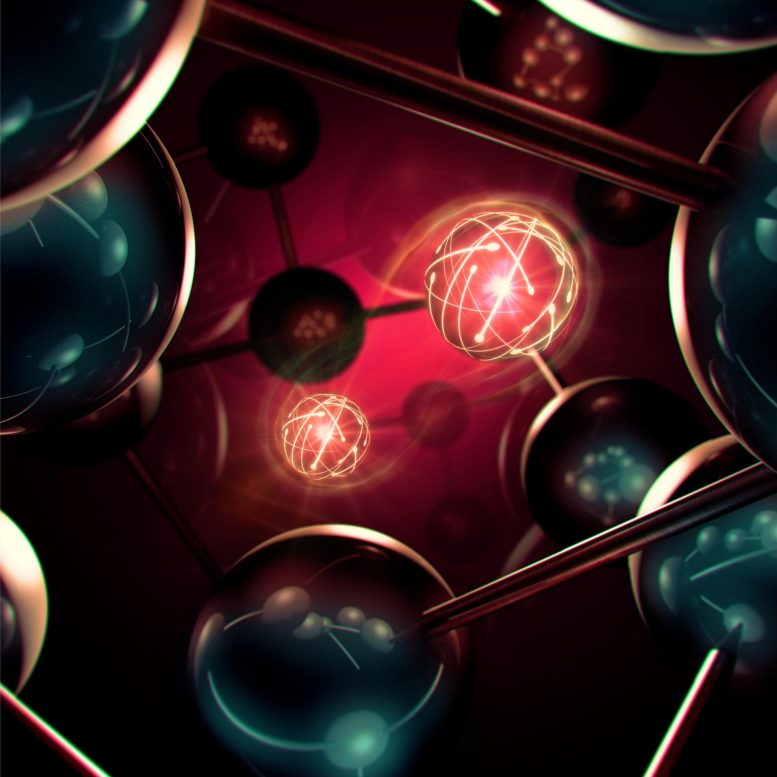
Computers, smartphones, GPS: quantum physics has enabled many technological advances. Now she is opening up new research fields in cryptography (the art of encrypting messages) with the aim of developing highly secure telecommunications networks. However, there is an obstacle: After a few hundred kilometers within a fiber optic, the photons carrying the qubits or “quantum bits” (the information) disappear. They therefore need “repeaters”, a kind of “relay” based in part on quantum memory. By managing to store a qubit in a crystal (a “memory”) for 20 milliseconds, a team from the University of Geneva (UNIGE) has set a world record and taken a major step towards the development of long-distance quantum telecommunications networks. This research can be found in the journal npj quantum information.
Quantum physics, developed in the 20th century, has enabled scientists to describe the behavior of atoms and particles and certain properties of electromagnetic radiation. By breaking with classical physics, these theories started a real revolution and introduced notions that are unparalleled in the macroscopic world, such as superposition, which describes the possibility that a particle can be in several places at the same time, or entanglement, which describes the The ability of two particles also describes the instantaneous effect on one another from afar (“spooky action at a distance”).
Quantum theories are now at the center of much research in cryptography, a discipline that brings together techniques for encrypting a message. Quantum theories make it possible to guarantee perfect authenticity and confidentiality for information (a qubit) when it is transmitted between two interlocutors by a particle of light (a photon) in an optical fiber. The phenomenon of heterodyning lets the sender know immediately if the photon carrying the message has been intercepted.
Saving the signal
However, there is a major obstacle to the development of long-distance quantum telecommunications systems: beyond a few hundred kilometers, the photons are lost and the signal disappears. Since the signal cannot be duplicated or amplified – it would lose the quantum state that guarantees its confidentiality – the challenge is to find a way to repeat it without altering it, by creating “repeaters” that specifically target based on a quantum memory.

Crystal used to store photonic qubits and illuminated by a laser in a cryostat, an instrument for obtaining cryogenic temperatures. Photo credit: (c) Antonio Ortu
In 2015, the team led by Mikael Afzelius, lecturer at the Institute of Applied Physics at the Faculty of Natural Sciences at the University of Geneva (UNIGE), managed to capture a qubit carried by a photon for 0.5 milliseconds in a crystal (a ‘memory’). This process allowed the photon to transfer its quantum state to the crystal’s atoms before disappearing. However, the phenomenon did not last long enough to allow the construction of a larger network of memories, a prerequisite for the development of long-distance quantum telecommunications.
memory record
Today, as part of the European Quantum Flagship program, Mikael Afzelius’ team has managed to significantly extend this duration by storing a qubit for 20 milliseconds. “This is a world record for a quantum memory based on a solid-state system, in this case a crystal. We even managed to get to the 100 millisecond mark with a small loss in fidelity,” the researcher says happily. As in their previous work, the UNIGE scientists used crystals doped with certain metals called ‘rare earth elements’ (in this case europium) that can absorb and then re-emit light. These crystals were stored at -273.15°C ([{” attribute=””>absolute zero), because beyond 10°C above this temperature, the thermal agitation of the crystal destroys the entanglement of the atoms.
“We applied a small magnetic field of one thousandth of a Tesla to the crystal and used dynamic decoupling methods, which consist in sending intense radio frequencies to the crystal. The effect of these techniques is to decouple the rare-earth ions from perturbations of the environment and increase the storage performance we have known until now by almost a factor of 40,” explains Antonio Ortu, a post-doctoral fellow in the Department of Applied Physics at UNIGE. The results of this research constitute a major advance for the development of long-distance quantum telecommunications networks. They also bring the storage of a quantum state carried by a photon to a time scale that can be estimated by humans.
An efficient system in ten years
However, there are still several challenges to be met. “The challenge now is to extend the storage time further. In theory, it would be enough to increase the duration of exposure of the crystal to radio frequencies, but for the time being, technical obstacles to their implementation over a longer period of time prevent us from going beyond 100 milliseconds. However, it is certain that these technical difficulties can be resolved,” says Mikael Afzelius.
The scientists will also have to find ways of designing memories capable of storing more than a single photon at a time, and thus of having ‘entangled’ photons which will guarantee confidentiality. “The aim is to develop a system that performs well on all these points and that can be marketed within ten years,” concludes the researcher.
Referemce: “Storage of photonic time-bin qubits for up to 20 ms in a rare-earth doped crystal” by Antonio Ortu, Adrian Holzäpfel, Jean Etesse and Mikael Afzelius, 15 March 2022, npj Quantum Information.
DOI: 10.1038/s41534-022-00541-3




